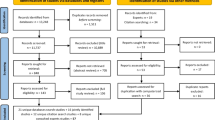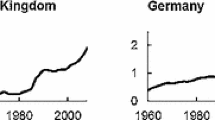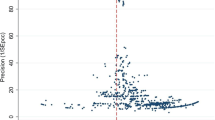Abstract
We investigate the role of Congress in the growth of federal public expenditure since 1930, building on the work of Kau and Rubin (Public Choice, 113:389–402, 2002). The model incorporates majority party strength and the extent of party control of Congress in addition to the median ideological position of elected representatives. We first provide estimates of the relative importance of the state of Congress and of trending supply and demand-side economic factors in the evolution of federal spending. The resulting models are then used to simulate the consequences of the radical and historically unprecedented shift to the right of Congress in 1994/95.
Similar content being viewed by others
References
Aldrich, J. H. (1995). Why parties? The origin and transformation of political parties in America. Chicago: University of Chicago Press.
Aldrich, J. H., & Rohde, D. W. (2000). The Republican Revolution and the House Appropriations Committee. Journal of Politics, 62(1), 1–33.
Aldrich, J. H., Rohde, D. W., & Tofias, M. W. (2004). One D is not enough: Measuring conditional party government, 1887–2002. Paper presented at a conference on the history of conference, Stanford University.
Aldrich, J. H., Rohde, D. W., & Tofias, M. W. (2007). One D is not enough: Measuring conditional party government, 1887–2002. In D. Brady & M. McCubbins (Eds.), Party, process, and political change in congress : Vol. 2. Further new perspectives on the history of Congress (pp. 102–112). Stanford: Stanford University Press.
Baumol, W. J. (1967). Macroeconomics of unbalanced growth: the anatomy of urban crisis. American Economic Review, 57(3), 415–426.
Borcherding, T. E., Ferris, J. S., & Garzoni, A. (2004). Changes in the real size of government since 1970. In J. Backhaus & R. Wagner (Eds.), Kluwer handbook in public finance. New York: Kluwer Academic Press.
Brennan, G., & Buchanan, J. (1980). The power to tax: Analytical foundations of a fiscal constitution. Cambridge: Cambridge University Press.
Cox, G. W., & McCubbins, M. D. (2007). Legislative Leviathan: Party government in the House. New York: Cambridge University Press.
de Cavalcanti, T. V. V., & Tavares, J. (2006). Women prefer larger governments: Growth, structural transformation and government size. Unpublished manuscript.
Dudley, L., & Witt, U. (2004). Arms and the man: World War I and the rise of the welfare state. Kyklos, 57(4), 475–504.
Erikson, R. S., MacKuen, M. B., & Stimson, J. A. (2006). Public opinions and congressional policy: A macro-level perspective. In S. Adler & J. Lapinski (Eds.), The macropolitics of Congress (pp. 79–95). Princeton: Princeton University Press.
Ferris, J. S., & West, E. G. (1996). Testing theories of real government size: U.S. experience, 1959–1989. Southern Economic Journal, 62, 537–553.
Ferris, J. S., Park, S., & Winer, S. L. (2007). Studying the role of political competition in the evolution of government size over long horizons. Carleton University, Department of Economics working paper. Revised January. www.carleton.ca/winers.
Grofman, B., Koetzle, W., Merrill, S., & Brunell, T. (2001). Changes in the location of the median voter in the U.S. House of Representatives, 1963–1996. Public Choice, 106, 221–232.
Groseclose, T., Levitt, S., & Snyder, J. (1996). Comparing interest group scores across time and chambers: Adjusted ADA scores for the U.S. Congress. American Political Science Review, 93(1), 33–50.
Higgs, R. (1987). Crisis and Leviathan: Critical episodes in the growth of American government. Oxford: Oxford University Press.
Hinich, M., & Munger, M. (1994). Ideology and the theory of public choice. Ann Arbor: University of Michigan Press.
Holcombe, R. G. (1993). Are there ratchet effects in the growth of federal government spending? Public Finance Review, 21(1), 33–47.
Holcombe, R. G. (2002). From liberty to democracy: The transformation of American government. Ann Arbor: University of Michigan Press.
Kau, J., & Rubin, P. (1981). The size of government. Public Choice, 37, 261–274.
Kau, J., & Rubin, P. (2002). The growth of government: Sources and limits. Public Choice, 113, 389–402.
Kenny, L., & Winer, S. L. (2006). Tax systems in the world: An empirical investigation into the importance of tax bases, administration costs, scale and political regime. International Tax and Public Finance, 13(2/3), 181–215.
Krehbiel, K. (1998). Pivotal politics: A theory of U.S. lawmaking. Chicago: University of Chicago Press.
Lopez, E. J., & Ramirez, C. D. (2004). Party polarization and the business cycle in the United States. Public Choice, 121, 413–430.
Lott, J. R., & Kenny, L. (1999). Did women’s suffrage change the size and scope of government? Journal of Political Economy, 107(6), 1163–1198.
MacKinnon, J. G. (1996). Numerical distribution functions for unit root and cointegration tests. Journal of Applied Econometrics, 11(6), 601–618.
Mayhew, D. R. (1991). Divided we govern: Party control, lawmaking and investigation, 1946–1990. New Haven: Yale University Press.
McCubbins, M. D. (1991). Party governance and U.S. budget deficits: Divided government and fiscal stalemate. In A. Alesina & G. Carliner (Eds.), Politics and economics in the eighties (pp. 83–111). Chicago: University of Chicago Press.
Mueller, D. (2003). Public choice III. Cambridge: Cambridge University Press.
Olson, M. (1965). The logic of collective action. Cambridge: Harvard University Press.
Peacock, A., & Wiseman, J. (1967). The growth of public expenditure in the United Kingdom. London: George Allen and Unwin.
Persson, T., & Tabellini, G. (2003). The economic effects of constitutions. Cambridge: MIT Press.
Poole, K. (2005). Spatial models of parliamentary voting. Oxford: Oxford University Press.
Poole, K., & Rosenthal, H. (1996). Congress: A political-economic history of role call voting. Oxford: Oxford University Press.
Rohde, D. W. (1991). Parties and leaders in the post reform House. Chicago: University of Chicago Press.
Tridimas, G., & Winer, S. (2005). The political economy of government size. European Journal of Political Economy, 21, 643–666.
Usher, D. (1986). Tax evasion and the marginal cost of funds. Economic Inquiry, 24, 563–586.
West, E. G. (1991). Secular cost changes and the size of government. Journal of Public Economics, 45, 363–381.
Author information
Authors and Affiliations
Corresponding author
Additional information
Research assistance was provided by Hyoek Ki Min, Can Hakyamez and Haizhen Mou. Winer’s research was supported by the Canada-U.S. Fulbright Program at Duke University and the Canada Research Chair Program.
Rights and permissions
About this article
Cite this article
Winer, S.L., Tofias, M.W., Grofman, B. et al. Trending economic factors and the structure of Congress in the growth of government, 1930–2002. Public Choice 135, 415–448 (2008). https://doi.org/10.1007/s11127-007-9270-x
Received:
Accepted:
Published:
Issue Date:
DOI: https://doi.org/10.1007/s11127-007-9270-x
Keywords
- Public expenditure
- Congress
- Ideology
- Majority party strength
- Party control
- Female labor force participation
- Stationary versus trending variables




